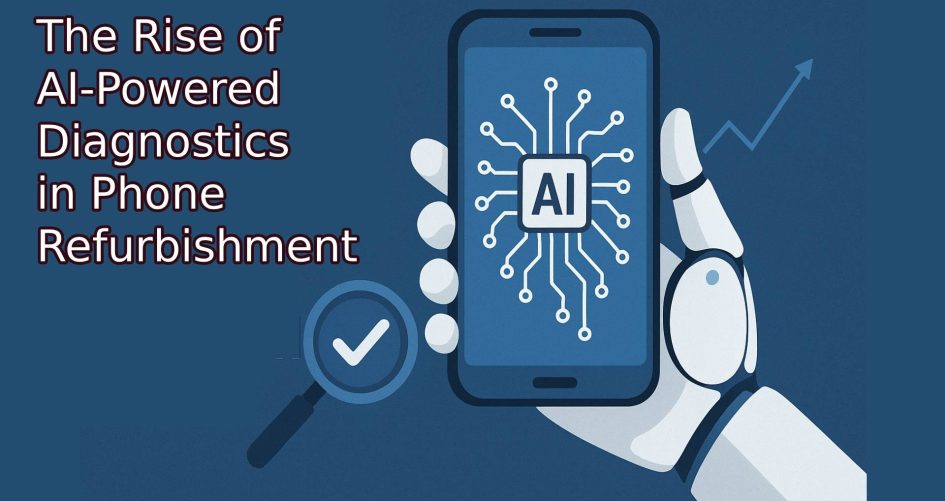Introduction: A New Era in Mobile Repair and Refurbishment
The mobile refurbishing industry is undergoing a radical transformation thanks to the introduction of AI in phone repair, advanced smart refurb tools, and highly efficient automated diagnostics systems. These innovations have not only streamlined the repair process but have also improved accuracy, reduced turnaround time, and elevated customer trust in refurbished devices. As demand for sustainable and affordable smartphones grows, embracing these technologies is becoming essential for wholesalers and repair technicians alike, making Phone Refurbishment smarter and more reliable than ever. Know more.
What is AI in Phone Repair?
How Artificial Intelligence Works in Diagnostics
AI in phone repair involves machine learning algorithms and neural networks that analyze data from device components to identify faults and malfunctions. These systems can simulate human reasoning by analyzing complex device behavior, which makes them ideal for detecting issues that would be missed through manual testing.
Types of Issues AI Can Detect in Phones
- Battery health and cycle anomalies
- Touchscreen sensitivity irregularities
- Signal reception and antenna malfunctions
- Camera focus or clarity problems
- Internal sensor failures (gyroscope, accelerometer, etc.)
- Hidden software errors or bugs
By leveraging automated diagnostics, AI can perform multiple tests in a fraction of the time compared to traditional manual checks.
The Role of Automated Diagnostics in Refurbishment
Eliminating Human Error in Device Testing
One of the biggest advantages of automated diagnostics is the ability to minimize human error. Traditional methods often rely on visual inspection and physical button testing, which can lead to missed faults. AI-based systems, on the other hand, run comprehensive tests consistently without fatigue or oversight.
Improved Turnaround Time for Repairs
Smart refurb tools powered by AI can test and grade a device in under 5 minutes. This significantly boosts productivity for wholesale refurbishing businesses that deal with large volumes of mobile devices daily.
Smart Refurb Tools: The Backbone of Modern Workshops
Key Features of Smart Refurb Tools
- Touchscreen testing with sensitivity maps
- Audio loopback tests for microphones and speakers
- Battery diagnostics with charge cycle analysis
- Visual inspections using AI camera integration
- System performance benchmarking
These smart refurb tools integrate AI-powered analytics to enhance each stage of the refurbishment process, ensuring only high-quality devices are resold.
Examples of Leading Smart Diagnostic Platforms
- Phonecheck: Used widely by wholesalers for certification
- Blancco Mobile Diagnostics: Known for secure data erasure and diagnostics
- NSYS Tools: Offers real-time diagnostics and automatic device grading
Each platform brings unique benefits but shares a common goal: accurate, efficient refurbishment through automation.
Benefits of AI in Phone Repair
Enhanced Accuracy in Fault Detection
With AI in phone repair, devices are tested against thousands of data points, ensuring precision that surpasses traditional testing methods. This leads to better device reliability and fewer returns.
Reduced Labor Costs and Time Efficiency
Automating diagnostics reduces the need for manual labor and allows technicians to focus on complex repairs, optimizing workforce productivity.
Improved Customer Satisfaction Rates
Refurbished phones that undergo automated diagnostics are more likely to meet quality expectations, increasing customer trust and boosting brand reputation.
AI Integration in Refurbished Mobile Supply Chains
How AI Optimizes Inventory Management
AI tools track device conditions, test results, and grading in real-time. This allows suppliers to sort inventory based on quality tiers instantly and avoid bottlenecks in the supply chain.
Quality Assurance and Grading Automation
Smart refurb tools can generate standardized grading reports (A, B, C grade) with detailed breakdowns of the tests performed, ensuring transparency for end-buyers and distributors.
Challenges of Adopting AI and Automated Diagnostics
Initial Setup Costs and Staff Training
Investing in AI systems and smart refurb tools requires capital. Furthermore, training staff to use these systems effectively can take time.
Compatibility Issues with Older Models
While automated diagnostics are improving rapidly, some older devices may not be fully compatible with current AI tools. This requires a hybrid approach that combines AI with manual expertise.
Case Study: A Refurbishing Company Embraces Smart Refurb Tools
TechRevive, a mid-sized mobile refurbisher in the UK, implemented automated diagnostics using Phonecheck. Within three months, they reduced their testing time per device from 12 minutes to 3.5 minutes, increased throughput by 40%, and decreased return rates by 15%. The integration of AI in phone repair was the key driver behind these results.
How AI-Powered Diagnostics Improve Device Lifecycle Management
AI doesn’t stop at refurbishment. It continues to monitor devices throughout their lifecycle. By analyzing usage patterns, battery wear, and app behavior, AI in phone repair can predict future failures and recommend preventive maintenance or upgrades, adding value for end-users.
The Future of AI in Phone Repair and Refurbishment
The evolution of AI in phone repair is far from over. We’re moving toward predictive maintenance, where AI not only detects issues but forecasts them before they occur. In addition, blockchain integration for diagnostics logs, AR-assisted repairs, and cloud-based automated testing will revolutionize the refurbished phone industry.
FAQs about AI in Phone Repair and Smart Diagnostics
1. What is the role of AI in phone repair today?
AI is used to automate fault detection, reduce manual testing, and improve the accuracy of diagnostics in phone refurbishment.
2. Are automated diagnostics more reliable than manual checks?
Yes, automated diagnostics are consistent, faster, and less prone to human error, making them more reliable for high-volume refurbishing.
3. What are examples of smart refurb tools?
Popular tools include Phonecheck, NSYS Tools, and Blancco, which offer AI-powered diagnostics, reporting, and grading.
4. Can AI tools detect hidden or intermittent issues?
Advanced smart refurb tools use historical data and behavioral analysis to catch issues that may not appear during brief manual tests.
5. Are AI diagnostics cost-effective for small workshops?
Though initial costs can be high, AI tools save time, reduce returns, and improve customer trust — making them a long-term asset even for smaller refurbishers.
6. Will AI replace human technicians completely?
No. AI complements human skills by automating routine checks. Complex repairs still require human expertise.
Conclusion: Embracing the AI Revolution in Refurbishment
The integration of AI in phone repair, smart refurb tools, and automated diagnostics is redefining the mobile refurbishment industry. These technologies offer unmatched speed, precision, and efficiency — giving businesses a significant competitive edge. As more refurbishers adopt these systems, those who hesitate risk falling behind. To future-proof your refurbishment process and deliver exceptional results, embracing AI is not just an option — it’s a necessity. Know more.





